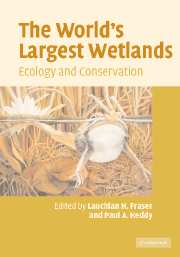Book contents
- Frontmatter
- Contents
- List of contributors
- Preface
- 1 Introduction: big is beautiful
- 2 The West Siberian Lowland
- 3 The Amazon River basin
- 4 The Hudson Bay Lowland
- 5 The Congo River basin
- 6 The Mackenzie River basin
- 7 The Pantanal
- 8 The Mississippi River alluvial plain
- 9 The Lake Chad basin
- 10 The River Nile basin
- 11 The prairie potholes of North America
- 12 The Magellanic moorland
- 13 The future of large wetlands: a global perspective
- Index
- References
8 - The Mississippi River alluvial plain
Published online by Cambridge University Press: 10 August 2009
- Frontmatter
- Contents
- List of contributors
- Preface
- 1 Introduction: big is beautiful
- 2 The West Siberian Lowland
- 3 The Amazon River basin
- 4 The Hudson Bay Lowland
- 5 The Congo River basin
- 6 The Mackenzie River basin
- 7 The Pantanal
- 8 The Mississippi River alluvial plain
- 9 The Lake Chad basin
- 10 The River Nile basin
- 11 The prairie potholes of North America
- 12 The Magellanic moorland
- 13 The future of large wetlands: a global perspective
- Index
- References
Summary
Introduction
The Mississippi River is the third-largest river in the world. It is the longest and largest river in North America, ranking third in length and watershed area and seventh in discharge among the world's largest rivers (Wiener et al. 1998). The river derives its name from the Ojibwa (Chippewa) Indian language, in which Mississippi means “great river” or “gathering of waters” – an appropriate name for a river that has a watershed that contains parts of 31 states in the United States and 2 Canadian provinces (Fig. 8.1). With its average discharge of about 15 400 m3s−1 (Gosselink et al. 1998), the Mississippi River accounts for roughly 90% of the freshwater inflow into the Gulf of Mexico (Dinnel & Wiseman 1986, National Oceanic and Atmospheric Administration 1987). Along with this water, it also delivers approximately 210 to 240 billion kg of sediments to its delta and into the Gulf of Mexico each year (Milliman & Meade 1983, Gosselink et al. 1998). The river can be divided into four major zones. The headwaters begin at Lake Itasca, downstream from the St. Anthony Falls in Minneapolis, Minnesota. The next section, often referred to as the “upper Mississippi River,” extends from the mouth of the Missouri River near St. Louis to the mouth of the Ohio River. The relatively narrow bands of batture lands (the floodplains contiguous with the river) along these two sections are highly populated and have been isolated from the river for over a century.
- Type
- Chapter
- Information
- The World's Largest WetlandsEcology and Conservation, pp. 272 - 315Publisher: Cambridge University PressPrint publication year: 2005



